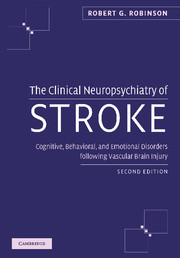 The Clinical Neuropsychiatry of Stroke
The Clinical Neuropsychiatry of Stroke Book contents
- Frontmatter
- Contents
- Preface
- Part I Introduction
- Part II Poststroke depression
- Part III Poststroke mania
- Part IV Poststroke anxiety disorders
- 29 Prevalence and specificity of clinical symptoms
- 30 Clinical and lesion correlates
- 31 Longitudinal course
- 32 Relationship of anxiety to outcome
- 33 Mechanism and treatment of poststroke anxiety disorder
- Part V Other poststroke disorders
- Index
33 - Mechanism and treatment of poststroke anxiety disorder
from Part IV - Poststroke anxiety disorders
Published online by Cambridge University Press: 01 October 2009
- Frontmatter
- Contents
- Preface
- Part I Introduction
- Part II Poststroke depression
- Part III Poststroke mania
- Part IV Poststroke anxiety disorders
- 29 Prevalence and specificity of clinical symptoms
- 30 Clinical and lesion correlates
- 31 Longitudinal course
- 32 Relationship of anxiety to outcome
- 33 Mechanism and treatment of poststroke anxiety disorder
- Part V Other poststroke disorders
- Index
Summary
Background
Several clinical studies have reported (Starkstein et al. 1990; Castillo et al. 1993; Astrom 1996), findings which must be explained by any hypothesis about the mechanism of poststroke anxiety. The major clinical finding is the frequent co-occurrence of anxiety disorder with depression. Approximately half of the patients with poststroke anxiety disorder were found to have major depression and about one-third minor depression. The second clinical finding is that the clinical and pathological correlates of anxiety disorder and depressive disorder are different. For example, the duration of anxiety disorder and depression are different. Anxiety but not depression is associated with prior alcohol abuse, acute onset anxiety but not acute onset depression is associated with right hemisphere lesion location, and anxiety and depression have independent or sometimes additive effects on recovery of activities of daily living (ADL), cognitive functioning, and social functioning.
Numerous hypotheses have been proposed to explain the neurobiological basis of anxiety disorders (Gorman et al. 1989) as well as the comorbidity of anxiety and depression. Paul (1988), for example, hypothesized that depression and anxiety may both be triggered by changes in the balance between inhibitory γ-aminobutyric acid (GABA) systems and excitatory noradrenergic systems. According to this theory, excessive arousal (perhaps created by the stress of stroke or other medical illness) may lead to decreased GABAergic inhibition, which could then lead to increased noradrenergic activity which produces the clinical manifestations of anxiety.
- Type
- Chapter
- Information
- The Clinical Neuropsychiatry of StrokeCognitive, Behavioral and Emotional Disorders following Vascular Brain Injury, pp. 347 - 354Publisher: Cambridge University PressPrint publication year: 2006


